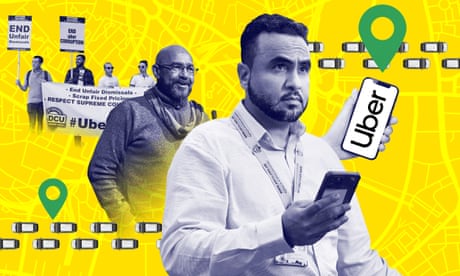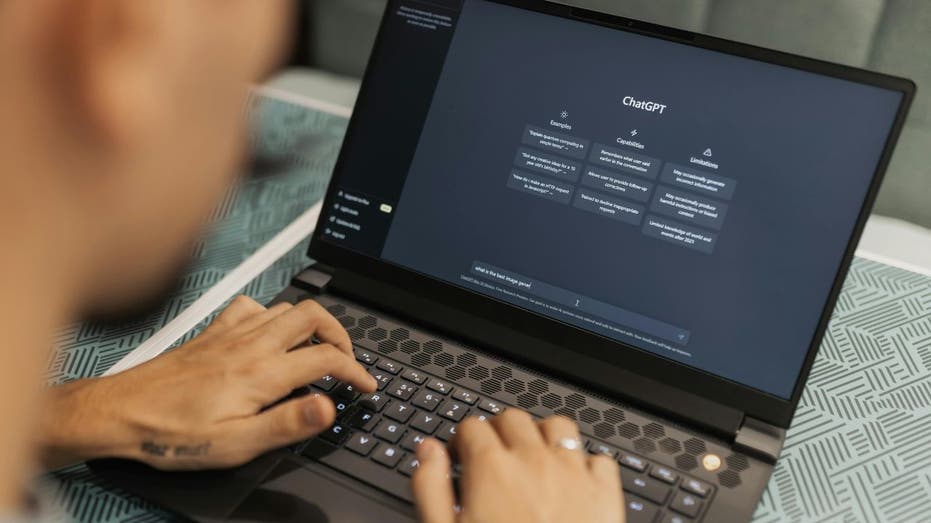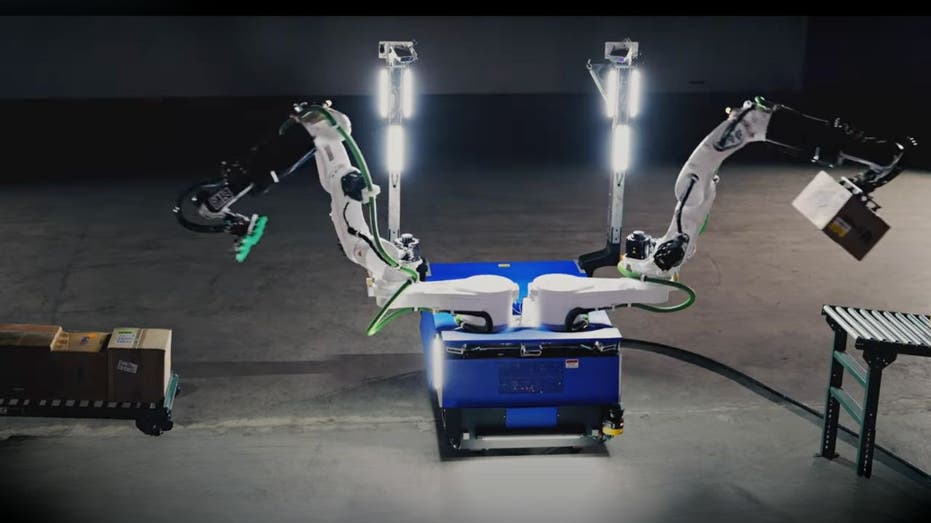- by foxnews
- 08 Apr 2025
‘They were taking us for a ride’: how Uber used investor cash to seduce drivers
‘They were taking us for a ride’: how Uber used investor cash to seduce drivers
- by theguardian
- 14 Jul 2022
- in technology

In the middle of the national rail strike last month when demand for cabs was sky-high, a group of Uber drivers decided they, too, would strike for 24 hours. A few hundred of them marched in protest to Uber's London office in Aldgate Tower, complaining of poverty pay and arbitrary management by algorithm.
It was a typical day for Abdurzak Hadi, an Uber driver, although he has to pinch himself to believe where he has ended up. The 44-year-old father of three arrived in England on his own in 1992 as a teenage refugee, having fled Somalia's brutal civil war. When he was old enough, he became a minicab driver. Then he signed up with Uber in 2014.
On the day of the strike, Hadi dropped his youngest son at school, then set off from his north London home on his bicycle to help lead the protest. As chair of the London branch of a radical new union, the App Drivers & Couriers Union (ADCU), Hadi is part of a David and Goliath campaign against tech giants.
He was one of 19 Uber drivers who took the company to court in 2015, originally with the help of the GMB union, to claim they were workers entitled to the legal minimum wage. Uber insisted that its drivers were self-employed contractors, as it has claimed all over the world. The UK drivers eventually won their case when the supreme court ruled in their favour in 2021. It had taken a six-year battle against Uber's endless appeals to assert their rights.
Hadi was in awe of the process. He thought: "Wow, how am I one of the guys sitting here in this court - an average person from Somalia, from a deprived background, coming to London, talking to other immigrant drivers, being able to take a huge corporation to court. It was unbelievable. I felt I was part of history."
Hadi likes being an Uber driver. He clearly remembers the excitement he felt at the promised revolution in the cab market when Uber launched in London. The US startup talked about empowering entrepreneurs, and gave the impression of a miraculous match of supply and demand, thanks to its algorithm, that would create well-paid jobs.
Uber was offering huge cash rewards to drivers and �50 credits to customers who brought their friends onboard. It was using billions of dollars of investor cash to pay for these subsidies to undercut rivals, seduce drivers on to the platform and to dominate the market.
"It was honey at that point, yeah honey," Hadi recalls.
But soon prices were cut. Waiting time increased as Uber flooded the market with cars. Then it raised the commission it took from drivers from 20% to 25%. Today Hadi reckons it takes him 14 hours to make what he was making in just five hours in the early days, and he believes Uber's commission can be 35% or even more at some times, although its pricing is opaque and variable. By 2015, Hadi found he was making so little as prices fell that his family qualified for tax credits - welfare payments for those in work on low pay. "So Uber is in effect heavily subsidised by you, the taxpayer."
Hadi remembers a moment of truth dawning when he experienced his first problem with violence. He had accepted a booking on the app for four passengers but found five drunken men waiting to get into his car. He refused them, as he was not licensed or insured for more than four. One of them smashed his car door in a rage. There was no friendly controller to call. The only way to report was a message through the app, to which he says he received what felt like a cut-and-paste reply.
He stuck with Uber, because he thought it would give him flexibility to choose where he worked. His son Mohamed was undergoing gruelling treatment for leukaemia so Hadi worked for Uber in the area around Great Ormond Street hospital, accepting trips for a few hours at a time before breaking off to take over from his wife at Mohamed's bedside, and then going back out to earn more. But the flexibility was not as good as he hoped; he often found himself sent miles away when he needed a return journey.
Despite all efforts to save him, Hadi's son died in 2019. The treatment was often very painful and Hadi is haunted to this day by a sense of guilt. "Was it worth it to put him through it all? You don't expect to bury your son, you expect the son to bury you. It's the worst thing that could happen to any parent." He still avoids accepting any Uber trips that take him near the hospital.
Uber says it now facilitates insurance for drivers in crisis moments. But at the time Hadi did not see any point in telling Uber what the family was going through. "There was no human interaction, no one to understand what misery you are going through. It's a system, and so only the system will get back to you. It's a system designed to manipulate drivers and to squeeze them as much as it can."
Drivers feature frequently in the Uber files, a cache of 124,000 company documents leaked to the Guardian. But mostly, they are referred to in the abstract as "supply" or "liquidity" - a commodity to be controlled by algorithm.
Uber says it now has about 3.5 million drivers, calling itself "one of the largest platforms for work in the world".
Many of those millions of drivers will be familiar with Uber's fluctuating pay scale. When entering new markets, it subsidised drivers heavily to attract a pool of cars large enough to offer an instant service to customers and to undercut taxis. These subsidies involved spending billions of investors' cash, and Uber looked to cut what it paid drivers as soon as it could, the leak suggests.
One presentation to dozens of Uber managers gathered for a summit in its Amsterdam headquarters in January 2015 reveals just how aggressively Uber subsidised rides in each city as it launched, and how it planned the price cuts that drivers such as Hadi experienced as a devastating loss of income.
In October 2014 in Madrid, the presentation shows, the hourly subsidy to drivers of $17.50 was almost twice the hourly fare it charged, which was only $9.10. In Berlin, the gross hourly fare Uber charged was $2.20, while the subsidy it paid out to drivers was $10.20 an hour.
Uber burned through cash to "buy revenue", in the words of the presentation. At the same meeting a senior manager gave a talk about "burning the burn" - that is, cutting subsidies.
"Young city: you are still subsidising your market. Get a real feel for the net fare/hour at which supply scales. Make sure drivers don't end up making more than they need to stick around," one of the slides said. In cities such as Paris, where Uber had been operating for some time, the subsidy had been cut and the company was paying out incentives of only $0.10 an hour, while bringing in revenue of $23.40 an hour. Drivers were already being squeezed. In Cape Town, initial Uber subsidies equivalent to $4 an hour were cut to nearly zero.
Derick Ongansie, 66, remembers the impact of those cuts clearly. He had invested in three vehicles to become an Uber driver entrepreneur in Cape Town in 2014 after a break from work due to cancer. He was enticed by Uber presentations on how much could be made. For the first year, he said, it was very lucrative and he could make "fantastic" money, up to $290 a day. But a year later, he said, Uber started withdrawing some of the incentives and then it introduced a new Uber service paying a fraction of the fare. The commission it took went up. "That's when we all started crashing. Uber was taking us for a ride," he said.
In his third year driving with Uber, he says, he made about one-third of what he made in his first year. After expenses, including fuel, insurance, phone and car maintenance, he calculated his pay often came to less than $1 an hour.
Drivers around the world were feeling the same effects.
Uber disputed that initial large subsidies followed by inevitable cuts were an inherent part of its business model for expansion. "Our interests are aligned with drivers, ensuring they have a positive experience of earning on the platform," said Uber's head of public affairs, Jill Hazelbaker, adding that otherwise drivers would go elsewhere.
The Uber files suggest that where drivers fought back, Uber adjusted the algorithm to buy its way out. When it cut prices and driver payments in Italy in October 2014, a manager reported back on an "attempted strike/mutiny, with extremely low supply, around 50 drivers teaming up to be offline", adding: "This led us to apply extraordinarily high incentives this past week, which worked better than expected: 300-400 supply hours more than forecast." It had, he said, cost "a burn rate of 38%".
This use of dynamic pricing to manipulate workers' decisions about when, where and how long they work, and how many drivers are in any area, is at the core of Uber's business model. By insisting when it launched that its drivers were independent contractors, it offloaded the costs and risk of providing a transport service on to them. It described itself as a tech company rather than a service provider. But the reality, the UK supreme court found, was that it controlled drivers in considerable detail and they were its workers.
With fuel costs soaring and prices not matching their increased costs, some drivers today feel not just controlled, but trapped. Many took out loans to buy cars to Uber's specification on the promise of high incomes, only to find when prices fell that they needed to work very long hours to service their debts before even beginning to make a living.
Hadi and fellow drivers' supreme court victory was a landmark for workers in the gig economy. Some GMB driver members settled after that, and Uber says it now has a more collaborative approach that includes working with unions. The GMB union signed a collective agreement with Uber in May 2021, and the company now pays holiday pay and pension contributions, as well as the hourly minimum wage. It says its commission in London was in line with its global average of 23% last quarter.
"With demand up following the pandemic, UK Uber drivers are earning more than ever - in the first quarter of 2022, they earned on average �29.72 per hour, including holiday pay, when actively engaged on the app. The combination of higher earnings, new protections such as holiday pay and trade union recognition in the UK has led to more than 10,000 new drivers signing up with Uber in recent months."
The figure of �29.72 is after Uber's commission is deducted but before drivers' costs for car hire, insurance and fuel are taken into account. Uber allows drivers 45p a mile for costs - the figure set by HMRC more than 10 years ago - when it checks whether they have fallen below the hourly minimum wage.
GMB's national officer for transport, Mick Rix, said he had a shopping list of concessions he now hoped to negotiate, including higher rates for drivers to reflect true fuel costs, and better support from Uber for drivers who suffer unfair ratings or abuse from passengers. "It's going well; we've had lots of dialogue with senior management," he said.
But for the ADCU the struggle is not over, because Uber refuses to include drivers' waiting time when calculating what it must pay them.
To be "everyone's private driver", as the Uber's slogan claims, the company requires a surplus of cars waiting just a few minutes away when a customer opens its app, the ADCU says. For drivers, waiting time often accounts for 35-45% of their time logged on. Pay for waiting time and access to their data were key demands of the strikers in June.
Hadi works exclusively on the Uber app, but the company says drivers in the UK are able to work on other apps while signed up with Uber and it therefore makes no sense to pay waiting time when they could be multi-apping.
The fightback has spread around the globe. Drivers in Spain, Switzerland, the Netherlands and France have won rights as Uber workers in several recent court rulings. In South Africa, Ongansie helped organise protests and was one of seven drivers who took Uber to court over worker rights. They won, but Uber overturned the ruling on appeal on a technicality: since they worked for Uber HQ in the Netherlands, it argued successfully that they would have to go more than 8,000 miles to bring their claim there.
Uber has fought back where workers have won rights. When a court ruled that drivers in California were employees, the company was part of a coalition of gig economy businesses that spent $220m to have the decision overturned in a referendum.
In London, Hadi now typically works 40-50 hours a week on the Uber app, over six days. If he deducts his operating costs, given the price of fuel, he reckons he makes about �8 an hour on Uber's measure - well below the UK legal minimum wage of �9.50 an hour. If he factors in his waiting time, he says gets only about �5-6 an hour after costs. Uber did not comment when presented with these figures.
"The honey is gone, now it's vinegar," he said.
So why does he carry on working for Uber? "I love driving and meeting and talking to lots of people. And I can't go elsewhere because they control so much of the London market, there's not enough work left elsewhere." Also, his old minicab company no longer exists.
Interview in Cape Town by Doug MacMillan of the Washington Post.
- by foxnews
- descember 09, 2016
Ancient settlement reveals remains of 1,800-year-old dog, baffling experts: 'Preserved quite well'
Archaeologists have recently unearthed the remarkably well-preserved remains of a dog from ancient Rome, shedding light on the widespread practice of ritual sacrifice in antiquity.
read more





